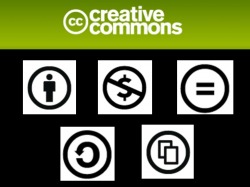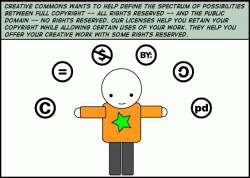Alternatives to Bill C-61 - Creative Commons
There are several forms of copyright law that would much more fair and equitable than Bill C-61. One of the most popular forms that balance the rights of producers and consumers is the Creative Commons. Copyright Law is a world of extremes. Either every last use of a work is regulated in the “all rights reserved” model, or anarchy, where all freedom is granted, but there is no protection from exploitation. The creative commons is used to bring back some degree of reasonableness and balance to copyright law. The licenses offered by creative commons protect the author’s works, but they allow specific uses by others. With a creative commons license, some rights are reserved. This means other creators can access the work’s source code.
This open source agreement is understood as a community centric sharing of knowledge that is used to develop collaborative information products and the sharing of information. This is made possible through the Internet’s information sharing abilities. Sharing further information makes more innovation possible. The license from Creative Commons was created for such types of works as websites, video, film, music, photography, etc. This makes your work freely available by requiring that any derivative works carry the patent license.Creative commons licenses allow for peer distribution, and for derivatives to be made and distributed under the terms of the original license. There are six types of copyright licenses offered by creative commons.
The first is called attribution, where you must attribute the work in the way specified by the one who holds the licence, but not in a way that suggests they endorse your work. You must make the licence terms of this work clear to others for distribution, which can be done by linking to the creative commons website. The second is called Attribution-No Derivative Works. The provisions are the same as for attribution, but you do not have the right to alter, transform or build upon the work in any way. You are free to share, to copy and distribute the work.
The third is called Attribution – No Commercial-No Derivative Works – The provisions are the same as No Derivative works, only you may not use this work for commercial purposes.
The fourth is Attribution – Non Commercial. You may share and distribute the work. You may remix the work by transforming it in any way. Attribution is essential. You may not use the work of commercial purposes. The fifth is Attribution – Non Commercial – Share Alike. As long as attribution is provided, you may share, copy, and distribute this work, and you may remix this work in any way. You may not use this work for commercial purposes. If this work is altered or transformed in ay way, it can only be distributed under the same or similar license to this one.
The sixth is Attribution – Share Alike – This is the same provisions as above. The only difference is that there is not the provision that it cannot be used for commercial purposes.
There are several forms of copyright law that would much more fair and equitable than Bill C-61. One of the most popular forms that balance the rights of producers and consumers is the Creative Commons.
This open source agreement is understood as a community centric sharing of knowledge that is used to develop collaborative information products and the sharing of information. This is made possible through the Internet’s information sharing abilities. Sharing further information makes more innovation possible. The license from Creative Commons was created for such types of works as websites, video, film, music, photography, etc. This makes your work freely available by requiring that any derivative works carry the patent license.Creative commons licenses allow for peer distribution, and for derivatives to be made and distributed under the terms of the original license. There are six types of copyright licenses offered by creative commons.
The first is called attribution, where you must attribute the work in the way specified by the one who holds the licence, but not in a way that suggests they endorse your work. You must make the licence terms of this work clear to others for distribution, which can be done by linking to the creative commons website. The second is called Attribution-No Derivative Works. The provisions are the same as for attribution, but you do not have the right to alter, transform or build upon the work in any way. You are free to share, to copy and distribute the work.
The third is called Attribution – No Commercial-No Derivative Works – The provisions are the same as No Derivative works, only you may not use this work for commercial purposes.
The fourth is Attribution – Non Commercial. You may share and distribute the work. You may remix the work by transforming it in any way. Attribution is essential. You may not use the work of commercial purposes. The fifth is Attribution – Non Commercial – Share Alike. As long as attribution is provided, you may share, copy, and distribute this work, and you may remix this work in any way. You may not use this work for commercial purposes. If this work is altered or transformed in ay way, it can only be distributed under the same or similar license to this one.
The sixth is Attribution – Share Alike – This is the same provisions as above. The only difference is that there is not the provision that it cannot be used for commercial purposes.
There are several forms of copyright law that would much more fair and equitable than Bill C-61. One of the most popular forms that balance the rights of producers and consumers is the Creative Commons.
Alternatives to Bill C-61 : Fair Dealing vs. Fair Use
In Canada, the fair dealing policy, which covers exceptions to copyright laws because of education and teaching, is much stricter than the similar fair use policy in the United States. One such difference is that in the United States, showing videos in the classroom without special privileges or performance rights is permitted. In Canada, a teacher must get public performance rights to show a video in the classroom. The United States allows making copies of works to distribute them to a class. In Canada, special permission, or payment to the copyright owner such as through the Copibec license must be granted.
Other differences include the fact that in the US, electronic journal entries can be sent to students who request them, but in Canada, this requires permission and payment to the rights holder. In the United States payment and permission isn’t necessary to show TV and radio performances to students outside the classroom. In Canada this can only be done with permission and payment to the copyright owner. In the United states, portions of any work, including those on the internet, can be posted on a restricted access website for students, for the purposes of teaching. Canada has no fair dealing policy for teaching.
Some of the things allowed by Canadian fair dealing policies are making single copies of portions of works for the purposes of research and private study. Unlike fair use in the U.S., however, Canada’s fair dealing does not contain exceptions for parody and satire. In order to be considered fair dealing in Canada, the work must be copied for research, private study, review or news report. Fair dealing also takes into account the number of copies, how they were distributed, to whom they were distributed, and if they were destroyed.
Fair dealing provisions in Canada are extremely limited. In order to create more equitable copyright regulations than those which bill C-61 are proposing, Canada should make its laws more similar to the fair use laws in the United States. It should be allowable to show videos in the classroom and hand out works for the purposes of teaching without payment or permission. Educators should have more leeway on what they choose to use in their classrooms. Parodies and satires should be seen as having merit in their own right, and have protection under Canadian law. Fair dealing should cover a lot more to make it truly fair.
Other differences include the fact that in the US, electronic journal entries can be sent to students who request them, but in Canada, this requires permission and payment to the rights holder. In the United States payment and permission isn’t necessary to show TV and radio performances to students outside the classroom. In Canada this can only be done with permission and payment to the copyright owner. In the United states, portions of any work, including those on the internet, can be posted on a restricted access website for students, for the purposes of teaching. Canada has no fair dealing policy for teaching.
Some of the things allowed by Canadian fair dealing policies are making single copies of portions of works for the purposes of research and private study. Unlike fair use in the U.S., however, Canada’s fair dealing does not contain exceptions for parody and satire. In order to be considered fair dealing in Canada, the work must be copied for research, private study, review or news report. Fair dealing also takes into account the number of copies, how they were distributed, to whom they were distributed, and if they were destroyed.
Fair dealing provisions in Canada are extremely limited. In order to create more equitable copyright regulations than those which bill C-61 are proposing, Canada should make its laws more similar to the fair use laws in the United States. It should be allowable to show videos in the classroom and hand out works for the purposes of teaching without payment or permission. Educators should have more leeway on what they choose to use in their classrooms. Parodies and satires should be seen as having merit in their own right, and have protection under Canadian law. Fair dealing should cover a lot more to make it truly fair.



